How to care for Christmas cactus is a question many plant lovers ask, especially when they see those beautiful blooms brightening homes during the holiday season.
You might have wondered, “Is it hard to care for one?” The short answer is no, but only if you understand what makes this plant different from the classic desert cactus. Despite its name, the Christmas cactus doesn’t hail from dry, sandy landscapes. It is a tropical plant that naturally grows in the shady, humid rainforests of Brazil.
That single fact transforms how you should care for it: more moisture, softer light, and a bit of seasonal TLC.
How to Care for Christmas Cactus?
Most people picture a spiky cactus living in the intense desert sun. The Christmas cactus (Schlumbergera) couldn’t be more different. In the wild, it grows in tree crevices or on rocks where it receives gentle, filtered light through the rainforest canopy. Its flattened, segmented stems aren’t built for harsh heat but for capturing moisture in a cooler, shaded environment.

This background explains why Christmas cactus care is closer to houseplant care than succulent care. Think consistent moisture, not dry soil. Think indirect light, not direct sun.
Types of Holiday Cactus (And How to Tell Them Apart)
Holiday cacti are often mislabeled, making it tricky to know what you actually have. Luckily, you can easily identify them by their stem shapes and blooming seasons.
1. Christmas Cactus (Schlumbergera bridgesii)
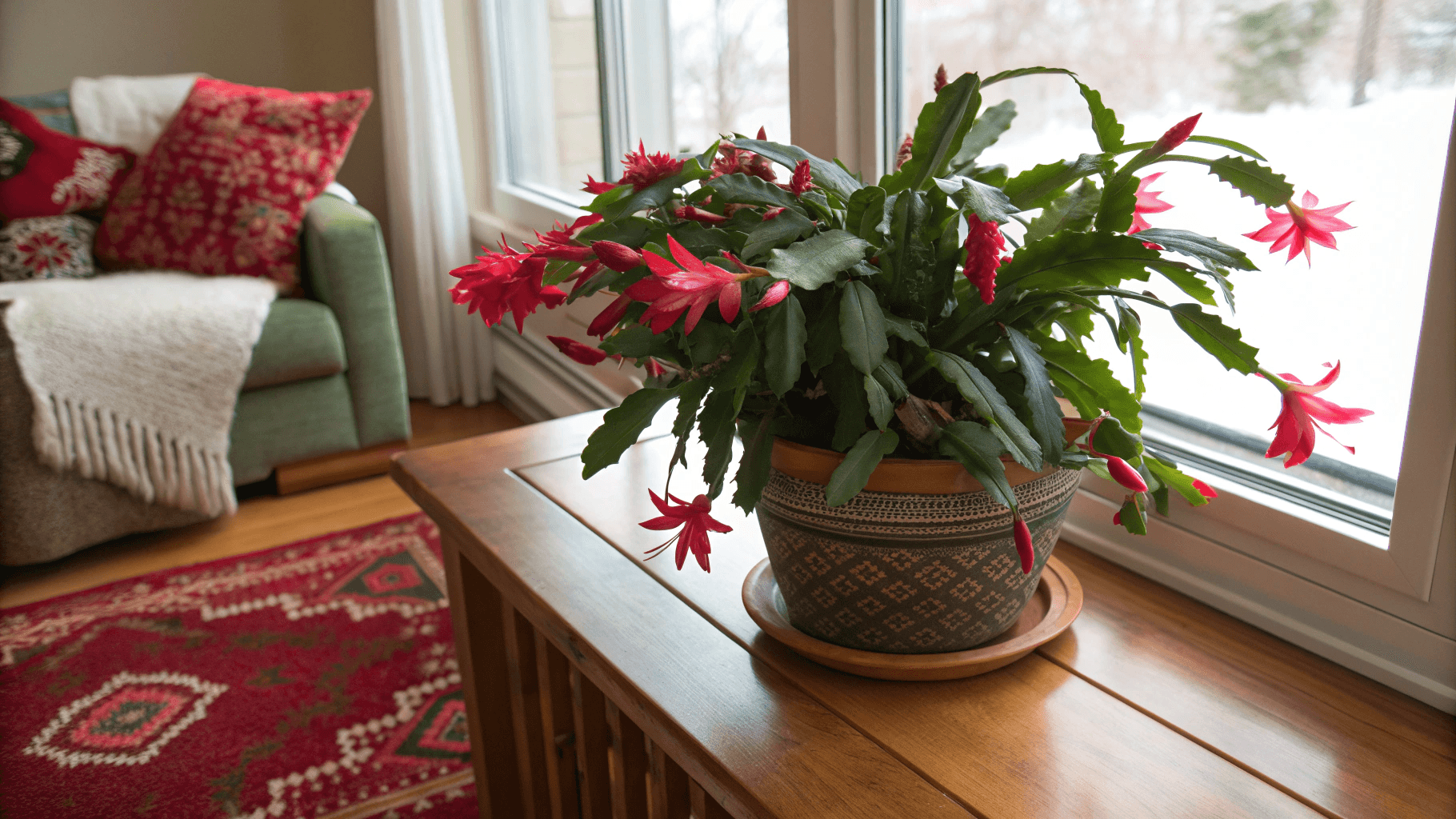
- Blooms in December-February
- Stem segments have rounded, scalloped edges
- Flowers hang down like delicate bells
2. Thanksgiving Cactus (Schlumbergera truncata)

- Blooms around late November
- Segments have sharper, claw-like points
- More common in stores (often mislabeled as Christmas cactus)
3. Easter Cactus (Rhipsalidopsis gaertneri)
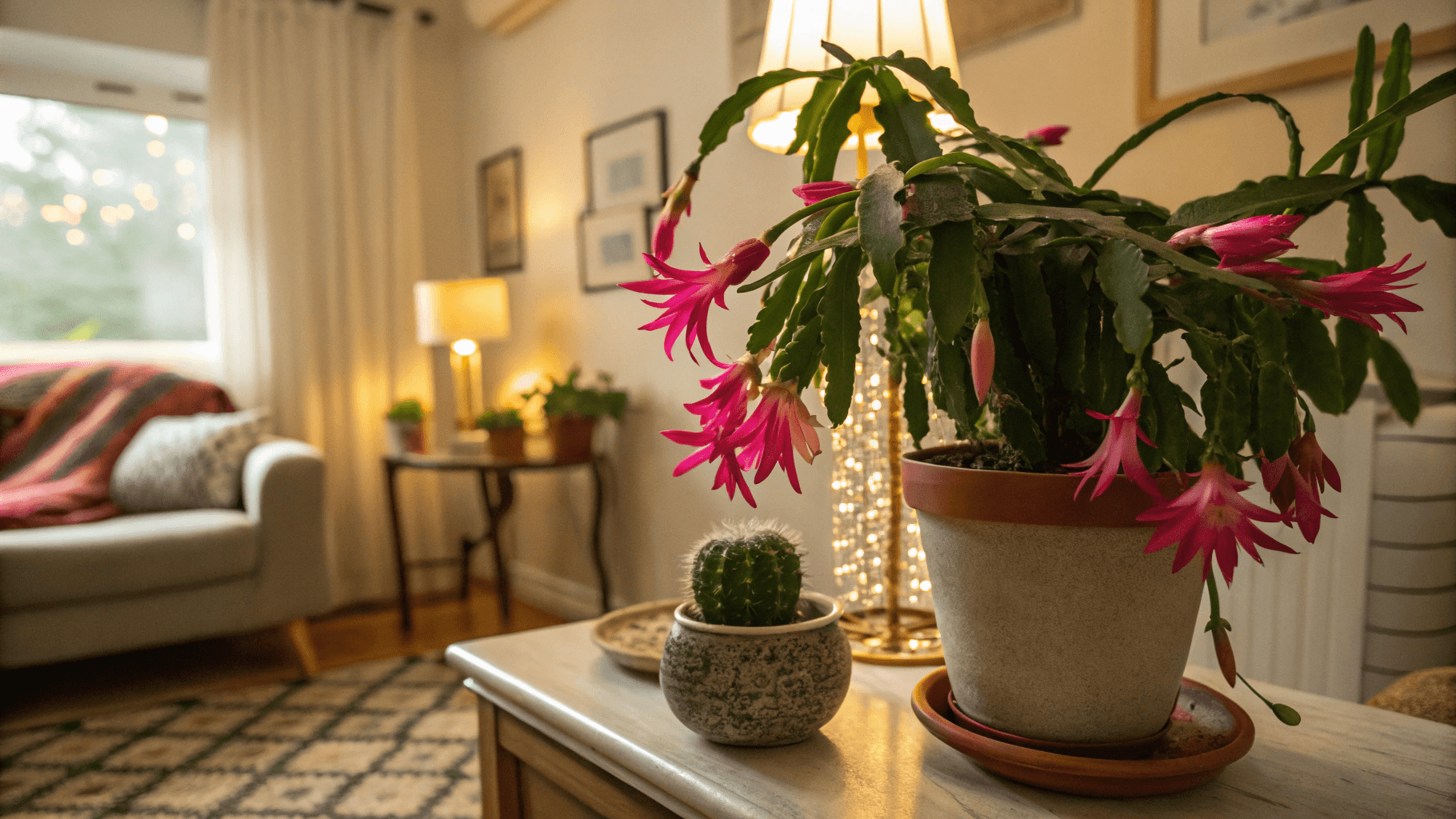
- Blooms in spring
- Segments are thicker and smoother with gentle bristles at the tips
- Flowers open fully like a star
Though their care is similar, knowing which one you have helps you understand its natural blooming cycle.
How to Care for Christmas Cactus with Proper Lighting
Getting the lighting right is one of the most important steps. Unlike desert cacti, this tropical plant thrives in bright but indirect light, mimicking the shaded canopy of its natural rainforest habitat.
Too much sun can scorch the leaves, while too little light can make your cactus leggy and slow to bloom.
Ideal Lighting
Christmas cactus prefers:
- Bright, indirect light
- East-facing windows (morning sun)
- North windows (soft, even light)
If the light is too strong, the plant becomes pale or scorched. Too little light, and it becomes leggy and slow to grow.
What to Avoid
- Direct midday sun, which can burn the stems
- Dark rooms where the plant stretches toward light
- Hot, dry window sills near heat sources
If your cactus lives in strong southern light, move it a few feet back from the window or use a sheer curtain.
Watering Schedule
This plant doesn’t like bone-dry soil, but it also hates sitting in water. The key is finding a rhythm that matches its seasonal needs.
Seasonal Watering Guide
Spring and Summer (active growth):
- Water when the top 1-2 inches of soil feel dry.
- Typically every 1-2 weeks.
Fall (bud formation):
- Keep the soil slightly more moist than usual.
- Don’t let it completely dry out.
Winter (after blooming):
- Reduce watering slightly.
- Water every 2-3 weeks, depending on indoor humidity.
Signs of Overwatering
- Squishy or limp stems
- Yellowing segments with brown edges
- Moldy soil or a sour smell
Signs of Underwatering
- Wrinkled, shriveled segments
- Drooping plant
- Dry, pulling-away soil
If you’re unsure, remember: It’s safer to underwater than overwater, but aim for steady moisture without soggy soil.
Best Soil and Potting Mix
Christmas cactus roots need excellent drainage, but the soil should also retain a bit of moisture, similar to orchid or succulent mixes, but gentler.
Best Potting Mix
- 2 parts high-quality potting soil
- 1 part perlite or pumice
- 1 part orchid bark or coco coir
This mix stays airy, drains well, and mimics a rainforest environment.
Recommended Pot Types
- Unglazed clay pots help prevent overwatering.
- Plastic or ceramic pots work if they have drainage holes.
- Wide, shallow pots fit the plant’s shallow root system.
Repot only every 2-3 years, preferably in spring.
Temperature and Humidity Needs
Remember, the Christmas cactus originates in humid, shaded jungles, so it needs a bit more moisture in the air than your average indoor cactus.
Ideal Temperature
- Day: 65-70°F (18-21°C)
- Night: 55-60°F (13-15°C)
Avoid placing it near heat vents, fireplaces, or cold drafts.
How to Boost Humidity Indoors
- Use a small humidifier nearby.
- Place the pot on a pebble tray with water (without letting the pot sit in water).
- Mist lightly during dry winter months (but avoid overdoing it).
How to Make a Christmas Cactus Bloom
Getting a Christmas cactus to bloom isn’t difficult, you just need to recreate its natural signals from the rainforest.
1. Photoperiod Changes (Shorter Days)
About 6-8 weeks before the holidays, the plant needs:
- 12-14 hours of darkness
- 8-10 hours of indirect light
A spare room or closet works well. Even streetlights can disrupt the process, so consistent darkness is important.
2. Temperature
Cooler nights help trigger bud formation. Keep nights around 55-60°F (13-15°C).
3. Feeding
From spring to early fall:
- Feed monthly with a balanced 10-10-10 or 20-20-20 fertilizer.
During bloom prep (fall):
- Switch to a high-potassium fertilizer once a month.
4. Avoid Moving the Plant
Once buds appear, avoid:
- Relocating the pot
- Drastic temp changes
- Letting it dry out
Any sudden stress may cause buds to drop.
Christmas Cactus Propagation
Propagating a Christmas cactus is not only easy, it’s one of the most rewarding ways to share your plant with friends and family.
Step-by-Step Stem Cutting
- Choose a healthy stem with 2-4 segments.
- Twist gently at the joint, don’t cut to separate it.
- Allow the cut to dry for 24 hours to form a callus.
- Prepare a small pot with moist, well-draining soil.
- Insert the cutting about ½ inch into the soil.
- Keep the pot in bright, indirect light.
- Water lightly when the top soil begins to dry.

Roots typically form in 2-4 weeks.
Water vs. Soil Propagation
Water Method:
- Place the cutting so only the bottom segment touches the water.
- Change water every few days.
- Move to soil when roots reach 1/2-1 inch.
Soil Method (preferred):
- Roots develop stronger and adjust better to long-term growth.
- Lower risk of rot when managed properly.
Common Christmas Cactus Problems and Fixes
Even with the best care, these plants can encounter a few issues. Here’s how to spot and fix the most common ones:
1. Yellow Leaves
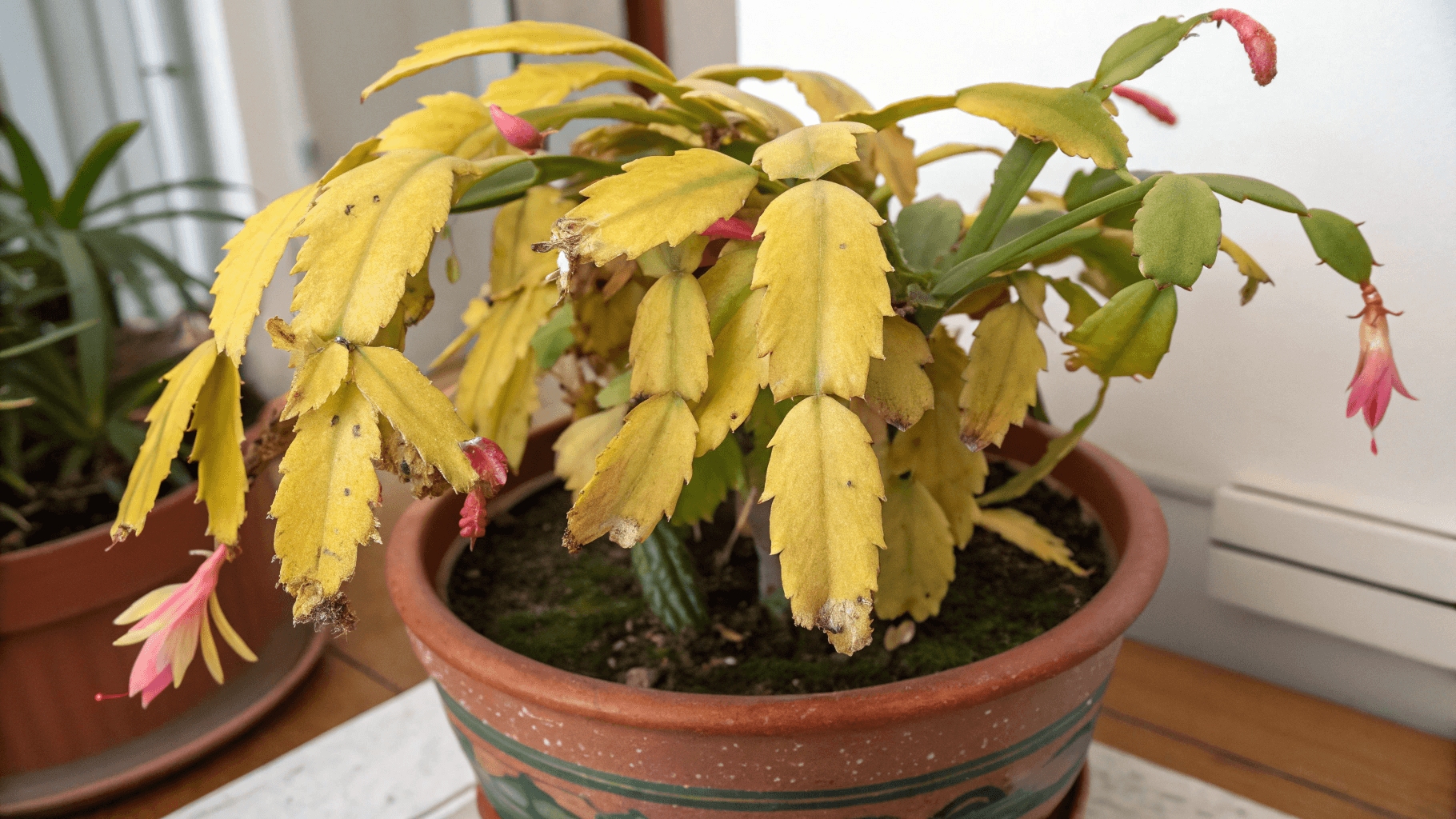
Cause: Overwatering, poor drainage, or too much direct light.
Fix:
- Allow the soil to dry slightly
- Move the plant to indirect light
- Repot in fresh, airy soil if roots seem stressed
2. Limp or Droopy Cactus

Cause: Underwatering or root issues.
Fix:
- Water thoroughly and let excess drain
- Check roots for rot
- Increase humidity
3. Root Rot
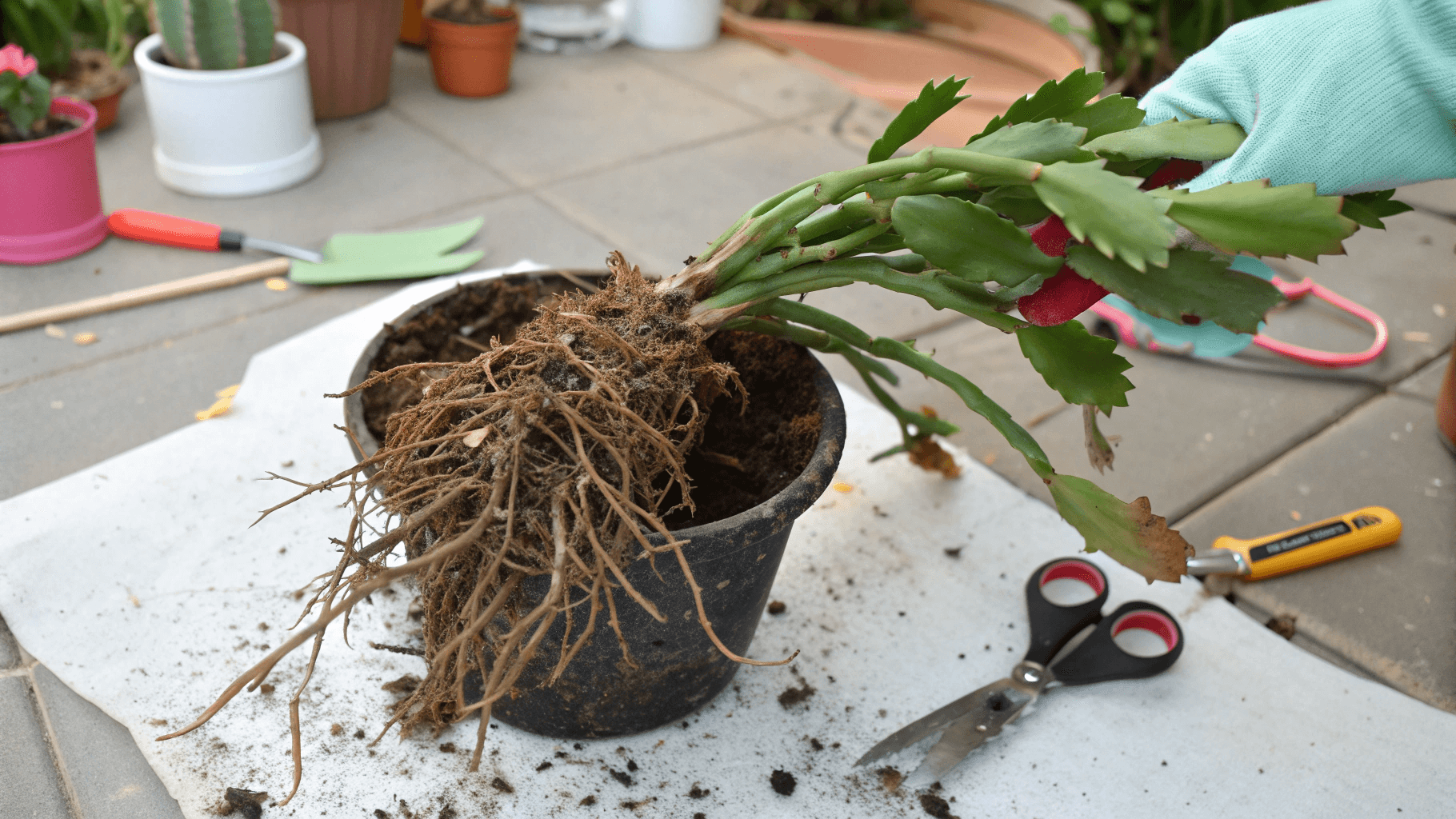
Cause: Consistently soggy soil.
Fix:
- Trim off mushy roots
- Repot in clean, dry soil
- Water less frequently
4. Buds Falling Off

Cause: Sudden changes in temperature, light, or watering.
Fix:
- Keep environment stable
- Avoid moving the plant during bud formation
Conclusion
Caring for a Christmas cactus becomes simple once you understand its rainforest origins. With the right balance of indirect light, steady moisture, and cooler fall temperatures, this plant can bloom reliably every year and even live for decades. By following these easy lighting, watering, propagation, and blooming tips, you’ll enjoy a lush, vibrant Christmas cactus that brightens your home through the holiday season and beyond.

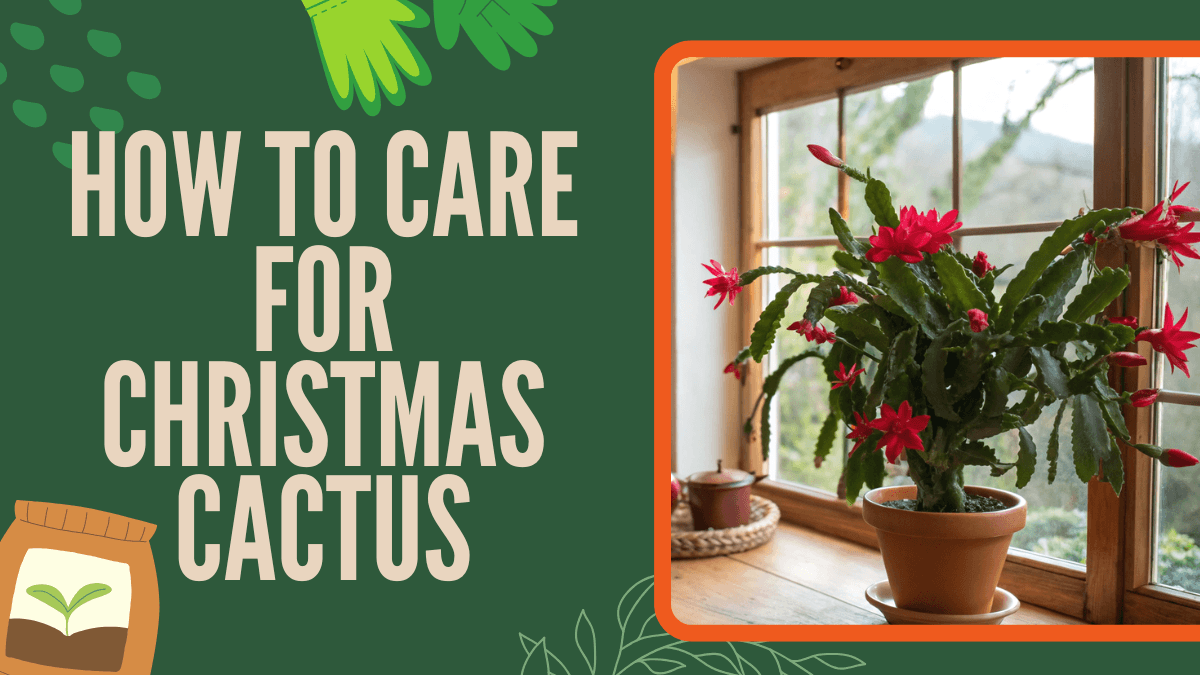
 ChatGPT
ChatGPT
 Perplexity
Perplexity
 Claude
Claude

Leave a Reply